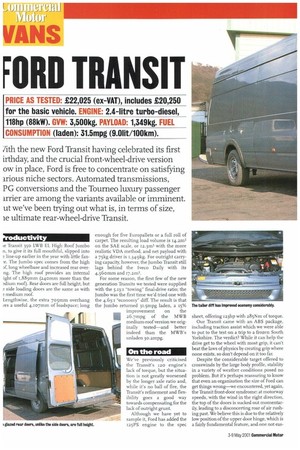FORD TRANSIT
Page 28

Page 29

If you've noticed an error in this article please click here to report it so we can fix it.
3RICE AS TESTED: £22,025 (ex-VAT), includes £20,250 for the basic vehicle. ENGINE: 2.4-litre turbo-diesel, 118hp (88kW). GVW: 3,500kg. PAYLOAD: 1,349kg. FUEL CONSUMPTION (laden): 31.5mpg (9.01it/100km).
iith the new Ford Transit having celebrated its first irthday, and the crucial front-wheel-drive version ow in place, Ford is free to concentrate on satisfying lrious niche sectors. Automated transmissions, PG conversions and the Tourneo luxury passenger irrier are among the variants available or imminent. ut we've been trying out what is, in terms of size, ie ultimate rear-wheel-drive Transit.
roductivity
ie Transit 35o LWB EL High Roof Jumbo n, to give it its full mouthful, slipped into line-up earlier in the year with little fan'e. The Jumbo spec comes from the high af, long wheelbase and increased rear overng. The high roof provides an internal ight of r,885rnm (24omm more than the Nlium roof). Rear doors are Cull height, but side loading doors are the same as with medium roof.
Lengthwise, the extra 7o5mm overhang ies a useful 4,1o7mm of loadspace; long enough for five Europallets or a full roll of carpet. The resulting load volume is 4.2m3 on the SAE scale, or 12.3m3 with the more realistic VDA method, and net payload with a 75kg driver is 1,349kg. For outright carrying capacity, however, the Jumbo Transit still lags behind the Iveco Daily with its 4,5 Gomm. and 17.2,m1.
For some reason, the first few of the new generation Transits we tested were supplied with the 5.13:1 "towing" final-drive ratio; the Jumbo was the first time we'd tried one with the 4.63:1 "economy" diff The result is that the Jumbo returned 31.5mpg laden, a 15% improvement on the 26.7mpg of the MWB medium-roof version we originally tested—and better indeed than the MWB's unladen 30.2mpg,
On the road
We've previously criticised the Transit's 120 engine's lack of torque, but the situation is not greatly worsened by the longer axle ratio and, while it's no ball of fire, the Transit's refinement and flexibility goes a good way towards compensating for the lack of outright grunt.
Although we have yet to sample it, Ford has added the 125PS engine to the spec
sheet, offering 123hp with aS5Nm of torque.
Our Transit came with an ABS package, including traction assist which we were able to put to the test on a trip to a frozen South Yorkshire. The verdict? While it can help the drive get to the wheel with most grip, it can't beat the laws of physics by creating grip where none exists, so don't depend on it too far.
Despite the considerable target offered to crosswinds by the large body profile, stability in a variety of weather conditions posed no problem. But it's perhaps reassuring to know that even an organisation the size of Ford can get things wrong—we encountered, yet again, the Transit front-door syndrome: at motorway speeds, with the wind in the right direction, the top of the doors is sucked out momentarily, leading to a disconcerting roar of air rushing past. We believe this is due to the relatively low position of the upper door hinge, which is a fairly fundamental feature, and one not eas
ily rectified. The long wheelbase makes for sure-footed handling for such a big box, but the extended rear overhang gives poor clearance of the rear step so care is needed when approaching steepish ramps, as we discovered within minutes of delivery.
This example didn't have the ultimate in security, having glazed rear doors (with wiped and heated glass) in place of the standard solid items. Fortunately the standard remote central locking with separate controls for cabin and loadspace is among the advanced security features that remain, together with the acdaimed high-security lock mechanisms.
As glazed rear doors would be fairly pointless with a solid bulkhead, ours had the benefit of full through rearward vision.
Summary
Although still not the largest van on the block, the Jumbo Transit certainly gives an extra dimension to the range, being more than capable of satisfying the needs of all but the most cube-hungry van buyers.
As we suspected all along, a sensible final-drive ratio has resulted in the sort of fuel economy we believed the Transit should be capable of, without any significant harm
to its performance. As time goes by, and the missing parts of the Transit jigsaw fall into place, the new range is showing signs of maturing into a worthy custodian of the treasured name.
■ by Coln Barnett
































































































